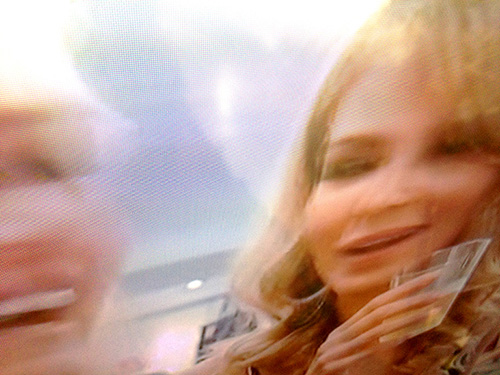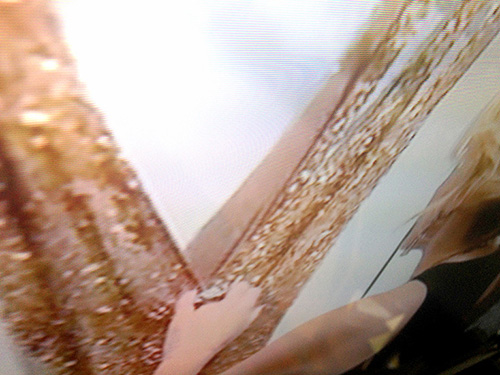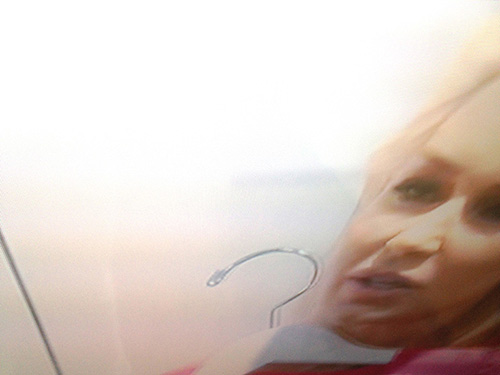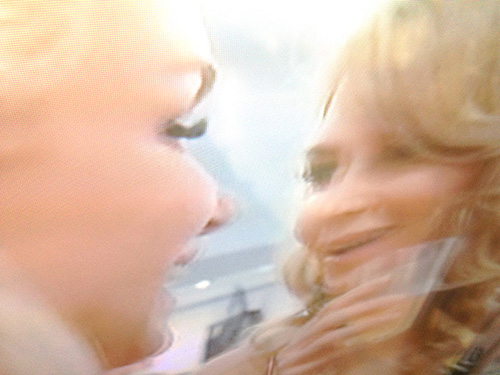For all its straight lines and family homes, Orange County can’t hide the reality of its bourgeois drag.
As a land rich in plastic, sprawling with tract homes and strip malls, Orange County has the suburban paradox of seeming to offer everything and yet nothing at all. Drawing on nothing, queers, weirdos, and punks exist in this straight place. Despite everything, they hang out or live out in suburbia, and nevertheless end up loving it.
The archetypically heterosexual suburban space we call the O.C. is rife with deviant sexualities and brimming with queer activity, even if just below its glossy surface. Where queer bodies inhabit Orange County’s master-planned spaces, their clandestine movements adulterate its ideologies of straightness and safety, reorienting its sanitized artifice through a queerer affection for lack. Who needs substance when you can have glitter? Who needs reality when you can have TV? Who wants to go shopping?

Taking a queerer look at suburbia would mean dislocating the geographic disparities in queer mythmaking. It would mean cruising elsewhere, bracketing our big-city dreams, and drawing in those queer desires that diffuse across spatial and social borders. Where urban spaces incite us to come out by the logic of authenticity, suburbia offers little in the way of such a centering narrative. Orange County poses a difficult place to find anything, let alone one’s true self. It’s where the real is augmented with artifice, cosmetically altered to appear bigger and flashier than nature might allow. It’s where a 4,000-square-foot house can reasonably be called cozy.
Whereas postwar suburbia was constructed in part to suppress queerness, championing the era of the nuclear family, it has still clung to an abnormal stake in seeming normal. Orange County’s histories of pioneering anti-queer legislation appear as a creepy fixation on appearing ordinary, betraying an underlying weirdness it knows it must suppress. It’s through this compensatory register, through meticulous planning and forced development, that the O.C. casts doubt on its supposed normalcy. By its own suburban logic of the inhered and natural, its contrived realness is rendered helplessly and suspiciously queer.
Its imitative effect is most evident in Orange County’s infrastructural aesthetics, where disparate elements seem to ape, uncannily, at far-flung places. Drive along the pseudo-Mediterranean coastline of Laguna Beach and you’ll see painstaking recreations of Spanish architecture; you’ll see neat rows of palm trees, planted to impress upon visitors a naturalized exoticism. It seems sadly fitting that Laguna Beach, once a thriving gay enclave, would ultimately find its queer histories subsumed by this very artifice, when reality television would cast photogenic teens in a whiter, straighter, and wealthier vision of its namesake city. But despite its representational inaccuracies, Laguna Beach (and shows like it) would manage to touch on the elaborate, spectral, and performative fantasies endemic to queer lives. In other words, Orange County discloses its own bourgeois drag through association with a medium that signifies trashiness and pretense, thus exposing an underlying architecture of camp aesthetics.
The aspirational ease of suburbia figures prominently into the seminal example of drag cinema, Paris Is Burning, a document of ball culture in 1980s New York. Though its cast is black and Latina, seropositive and poor, their desires pivot on their financial means, turning to an organizing principle of opulence (or as one queen literally spells out, O-P-U-L-E-N-C-E). Another figure, the charismatic Venus Xtravaganza, dreams of “being a spoiled, rich, white girl living in the suburbs,” her unrealized fantasies appearing scripted in Orange County, which may have failed her in its repressive politics, but nevertheless signified a life of luxury.

Venus’s suburban desires dovetail with their contemporary apogee in the Real Housewives series, first staged in Orange County, and centering on the goings-on of Southern California’s bourgeoisie. While the series has now extended to Atlanta, New York, and beyond, even its original O.C. iteration is spun from an elaborated camp aesthetics, mirroring the queer socialities captured in Paris Is Burning. The Real Housewives can, in this way, be imaged as an estranged and commercial stepchild of drag culture. Their franchised interstitial dynamics trace back to the drag formations of competing regional “houses,” their gossipy tendencies co-opting the rhetorical registers of throwing shade, reading, and realness.
In packaging queer sensibilities for mainstream audiences, lending televisual form to the upscale imaginaries of Paris’s queens, Bravo would appear to contain an aesthetics of opulence to the enterprises of its white, affluent women. But the queer appeal of Real Housewives might also turn on these material stakes, presenting an amusing, if embellished account of bourgeois life. A queer re-viewing of such shows would take seriously their extreme stupidity, revealing these explorations of “realness” to be parodies of normalcy itself.
For all their orientation toward adolescence, both queer and suburban accounts of the world are opposed to tidy accounts of coming-of-age, telling stories instead of an ongoing flux. If queerness undergirds a critical vagueness, the same could be said of suburbia, and particularly the type enacted in Orange County, where old-fashioned values are paired with shiny new stuff. Another strange coupling pairs Orange County’s sizable queer populace with its anti-queer politics, a tension animated between the culture wars of one-time state senator John Briggs (representing a broad swath of Orange County) and activist Harvey Milk, the first openly gay person to be elected to public office in California. Briggs, who spearheaded a failed proposition banning gays and lesbians from teaching, described Milk’s adopted hometown of San Franscisco as “the moral garbage dump of homosexuality in this country,” drawing up the so-called Orange Curtain between Southern and Northern California, and therefore between suburbia and the world at large.
Predictably, this conservative ethos would also make its way into Orange County’s famed amusement parks, which, despite more recently swearing by the oath of for-profit tolerance, have long held their own homophobic policies. In 1957, Disneyland instituted a ban on same-sex dancing that was left in place for 28 years. But in the way that legislating repression often works, this regulation would acknowledge that, far from being invisible or absent, queers performed enough homoerotic noodling to warrant censure at “The Happiest Place on Earth.”
As cultural theorist Karen Tongson notes, even these seemingly voided sites of Orange County can serve as staging grounds for queer activity. In Relocations, her dedicated study of suburban imaginaries, Tongson points to a notable example in Knott’s Berry Farm’s Studio K, an amusement park club designed to contain and monetize “the urban element … of underground cultures.” Despite Knott’s attempts to uphold a policy of inoffensiveness, sanctioning, for instance, Studio K’s use of hip-hop music, its DJs found ways of skirting around these rules, mashing up top 40’s singles with rap hits. These subtle movements between compliance and dissent reflected the collusion of queer bodies and manufactured entertainment, in how a venue like Studio K provided a space for suburban queers to dress up, go out, and dance together, and, simultaneously, provided the means for Knott’s to capitalize on those very desires. That the young, brown, and queer played to these fabricated sensibilities, while playing around Knott’s attempts to enforce them, demonstrates how “Orange County’s youth,” Tongson writes, “dismantled security simply by letting it amuse them.”

We might turn here to the late José Muñoz’s engagement of the ordinary and mainstream. Recounting his suburban childhood in South Florida, Muñoz describes watching Truman Capote on a talk show, marveling at the “swishy spectacle of [his] performance.” This mundane act discloses a process that Muñoz calls disidentification, whereby “minority subjects recycle and rethink encoded meaning” in order to “represent a disempowered politics… rendered unthinkable by the dominant culture.” Popular culture can thus serve as an unlikely means to recognize and cultivate queerness. Like fledgling femmes listening to Springsteen or fresh-faced dandies watching wrestling, we can learn to play with the media or spaces we’ve been given, seeking at alternatives where they seem least possible.
Attempting to disidentify with suburbia’s ornaments of excess would then mean rethinking its decorative fountains and prearranged patio sets. What’s queer about a three-car garage? Perhaps nothing, but perhaps a significant strain of nothing, as queers have tended to make use of the capacious and needless. Material excess may be suspect for all of the obvious reasons, but the imaginary or aesthetic of excess is less so. Going through with excess may be surprisingly informative, especially when it purports to align with family values.
Like marveling at the horrible housewives of Orange County, looking for queerness in Southern California’s suburban terrain would entail a similar kind of psychic conciliation. It would mean flipping through channels and sifting through records—all to ask how a space so hostile to queer activity could still contain the features to rally a paradoxical love for the O.C. Within the plastic sheen of Orange County glimmers the possibility of its unlikely queerness, and, stranger still, the possibility that its artificial and adopted environments might exemplify queerness by exemplifying nothing at all. The affective register of Orange County is one of missing something necessary: a course to orient who we are or should become. But in its mundaneness and lack lies a more complex vision of the world than would be admitted by its conservative reputation, or even by the packaged mythologies of identity politics.
Living in the void means divesting ourselves of an authentic existence, forgoing the tenuous project of self-actuation. Forget making it in the O.C. Out here, we’ve trashed what “it” is, paved it over, and turned it into a juice bar. What remains is an unshakable disquietude, a process of negotiation, and the queer feeling that things might still be okay, or, better yet, pretty chill.
